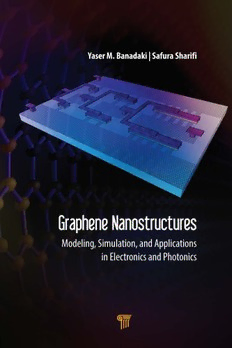Table Of ContentGraphene Nanostructures
Graphene Nanostructures
Modeling, Simulation, and Applications
in Electronics and Photonics
Yaser M. Banadaki
Safura Sharifi
Published by
Jenny Stanford Publishing Pte. Ltd.
Level 34, Centennial Tower
3 Temasek Avenue
Singapore 039190
Email: editorial@jennystanford.com
Web: www.jennystanford.com
British Library Cataloguing-in-Publication Data
A catalogue record for this book is available from the British Library.
Graphene Nanostructures: Modeling, Simulation, and Applications
in Electronics and Photonics
All rights reserved. This book, or parts thereof, may not be reproduced in any form
Copyright © 2019 by Jenny Stanford Publishing Pte. Ltd.
or by any means, electronic or mechanical, including photocopying, recording
or any information storage and retrieval system now known or to be invented,
without written permission from the publisher.
For photocopying of material in this volume, please pay a copying fee through
the Copyright Clearance Center, Inc., 222 Rosewood Drive, Danvers, MA 01923,
USA. In this case permission to photocopy is not required from the publisher.
ISBN 978-981-4800-36-5 (Hardcover)
ISBN 978-0-429-02221-0 (eBook)
Contents
Preface
1. In troduc tion to Graphene i1x
1.1 Physical Geometry and Properties 1
2. 1G.r2a phenGer afoprh Ienntee gNraatneodr iCbirbcounit s 167
2.1 Introduction 17
2.2 Scaling Challenges of Silicon Electronics 18
2.3 Graphene-Based Field-Effect Transistors 20
3. 2Co.4m putGatriaopnhael nCea-rBriaesre Tdr aInnstepgorrat tMedo Cdeirlc oufi tGsN RFET 2227
3.1 Introduction 27
3.2 Quantum Transport Model 32
3.3 Quantum Capacitance in GNRFET 39
3.4 Computational Time 43
4. 3Sc.5a ling ESfufemcmts aorny Performance of GNRFETs 4449
4.1 Introduction 49
4.2 Device Structure 50
4.3 Transfer Characteristics of GNRFETs 51
4.4 Scaling Effects on Static Metric of GNRFETs 54
I I
4.4.1 OFF-Current 54
4.4.2 ON/ OFF Ratio 54
4.4.3 Subthreshold Swing 56
4.4.4 Drain-Induced Barrier Lowering 56
4.4.5 Voltage Transfer Characteristic 59
4.5 Scaling Effects on Switching Attributes of
GNRFETs 62
4.5.1 Intrinsic Gate Capacitance 62
4.5.2 Intrinsic Cut-off Frequency 63
4.5.3 Intrinsic Gate-Delay Time 64
vi Contents
4.5.4 Power-Delay Product 66
5. 4W.6id th-DSeupmenmdaernyt Performance of GNRFETs 6771
5.1 Introduction 71
5.2 Device Structure 72
5.3 GNR Sub-bands 74
5.4 Width-Dependent Static Metrics of GNRFETs 77
I I
5.4.1 OFF-Current 81
5.4.2 ON/ OFF Ratio 83
5.4.3 Subthreshold Swing 83
5.5 Width-Dependent Switching Attribute of
GNRFETs 85
5.5.1 Threshold Voltage 85
5.5.2 Transconductance 87
5.5.3 Intrinsic Gate Capacitance 88
5.5.4 Intrinsic Cut-off Frequency 89
5.5.5 Intrinsic Gate-Delay Time 91
6. 5A. 6SP ICE SPuhmysmicas-rBya sed Circuit Model of GNRFETs 9915
6.1 Introduction 95
6.2 GNRFET Structure 97
6.3 GNRFET Model 98
6.3.1 Computing GNR Sub-bands 99
6.3.2 Finding Channel Surface Potential 100
6.3.2.1 Computing channel charge 101
6.3.2.2 Computing transient
capacitance charge 102
6.3.3 Current Modeling 103
6.3.3.1 Computing thermionic
current 104
6.3.3.2 BTBT current and charge 104
6.3.4 Non-ballistic Transport 106
6.3.5 Extracting Fitting Parameters 110
6.4 Model Validation 112
6.4.1 Comparing with Computational
NEGF Formalism 112
6.4.2 Comparing with Many-Body Problem 114
Contents vii
6.5 Effect of Edge Roughness on Device
Characteristic 117
6.5.1 Transfer Characteristics of GNRFETs 117
6.5.2 OFF-State Characteristics of GNRFETs 118
7. 6G.r6a phenSeu-mBamseadry C ircuit Design 111295
7.1 Introduction 125
7.2 All-Graphene Circuits 126
7.3 Graphene Inverter 127
7.4 Power and Delay of GNRFET Circuits 130
7.5 GNRFET-Based Energy Recovery Logic Design 135
8. 7G.r6a phenSeu mSemnsairnyg and Energy Recovery 114427
8.1 Introduction 147
8.2 GNRFET-Based Temperature Sensors 148
8.3 GNRFET for Energy Harvesting 153
8.3.1 Thermoelectric Model 154
8.3.2 Electrical Conductivity 156
8.3.3 Seebeck Coefficient 157
8.3.4 Electrical Thermal Conductivity 158
ZT
8.3.5 Power Factor 158
8.3.6 Thermoelectric Figure-of-Merit 160
9. 8G.r4a phenSeu mPhmoatorny ic Properties and Applications 116615
9.1 Introduction 165
9.2 Photonic Properties 167
9.3 Graphene Photonic Applications 168
9.3.1 Transparent Conductive Films and
Passive Photonic Devices 169
9.3.2 Photodetectors 170
9.3.3 Optical Modulator 171
9.3.4 Mode-Locked Laser 171
9.3.5 THz Wave Generator 172
9.3.6 Optical Polarization Controller 172
9.4 Optical Conductivity Model of Graphene 173
9.5 Summary 178
viii Contents
10. Graphene-Based Thermal Emitter 185
10.1 Introduction 185
10.2 Thermal Emitter and Blackbody Radiation 186
10.3 Tunable Narrowband Thermal Emitters 188
10.4 Graphene-Based Aperiodic Multilayer Structure 190
10.5 Selectivity, Tunability, and Switchability 192
Index10.6 Summary 197
205
Preface ix
Preface
Over the past few decades, there have been tremendous innovations
in electronics and photonics. Integrated circuits are everywhere and
an indispensable part of our life, ranging from portable electronics
to telecommunications and transportation. It is estimated that more
than 1 trillion semiconductor devices shipped for the first time in
2016 with a rising demand due to new application areas such as
the Internet of things, wearable electronics, and robotics. According
to the Semiconductor Industry Association, the semiconductor
industry is responsible for the direct employment of roughly a
quarter of a million and indirectly supports another 1 million jobs
only in the United States.
The development of ultra-fast-growing technologies mostly
relies on fundamental understanding of novel materials with unique
properties as well as new designs of device architectures with more
diverse and better functionalities. In this regard, the promising
approach for next-generation nanoscale electronics and photonics is
to exploit the extraordinary characteristics of novel nanomaterials.
The discovery of graphene, one atomic layer of carbon sheet, in
2004 has prompted research into its potential in developing future
electronic and photonic devices owing to its exceptional electronic,
photonic, and mechanical properties.
The driving engine for the exponential growth of digital
information processing systems is scaling down the transistor
dimensions. For decades, this has enhanced the device performance
and density. However, the International Technology Roadmap for
Semiconductors (ITRS) states the end of Moore’s law in the next
decade due to the scaling challenges of silicon-based complementary
metal-oxide semiconductor (CMOS) electronics, e.g., extremely
high power density. A large group of emerging materials and
devices is being extensively studied to replace silicon due to its
scaling limit in sight. Germanium has been substituted by silicon
roughly half a century ago by moving up on group IV of the periodic
table. Interestingly, moving up one more block, we reach carbon,

